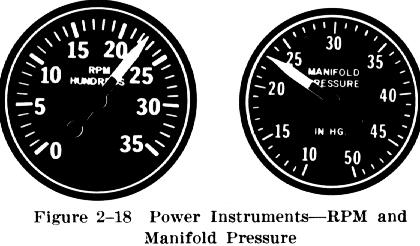
An airplane equipped with a fixed pitch propeller has only one main
power control - the throttle. In that case, the setting of the throttle
will control both the amount of power and the propeller or engine RPM.
 |
On the other hand, an airplane equipped with a constant speed propeller has two main power controls - a throttle and a propeller control. The throttle controls the engine's power output which is indirectly indicated on the manifold pressure gauge. The propeller control changes the pitch of the propeller blades and governs the RPM which is indicated on the tachometer (Fig. 2-18). As the throttle setting (manifold pressure) is increased, the pitch angle of the propeller blades is automatically increased through the action of the propeller governor system. |
This increase in propeller pitch proportionately increases the air load on the propeller so that the RPM remains constant. Conversely, when the throttle setting (manifold pressure) is decreased, the pitch angle of the propeller blades is automatically decreased. This decrease in propeller pitch decreases the air load on the propeller so that the RPM remains constant.
On most airplanes, for any given RPM, there is a manifold pressure that should not be exceeded. If an excessive amount of manifold pressure is carried for a given RPM, the maximum allowable pressure within the engine cylinders could be exceeded, placing undue stress on them. If repeated too frequently, this undue stress could weaken the cylinder components and eventually cause engine structural failure.
What can the pilot do to avoid conditions that would possibly overstress the cylinders? First, there must be a constant awareness of the tachometer indication (engine RPM), especially when increasing the throttle setting (manifold pressure). Then, the pilot should know and conform to the manufacturer's recommendations for power settings of a particular engine to maintain the proper relationship between manifold pressure and RPM. The combination to avoid is a high throttle setting (manifold pressure indication) and a low RPM (tachometer indication).
When both manifold pressure and RPM need to be changed significantly, the pilot can further help avoid overstress by making power adjustments in the proper order. On most airplanes when power settings are being decreased, reduce manifold pressure before RPM. When power settings are being increased, reverse the order - increase RPM first, then manifold pressure. If RPM is reduced before manifold pressure, manifold pressure will automatically increase and possibly exceed manufacturer's tolerances.